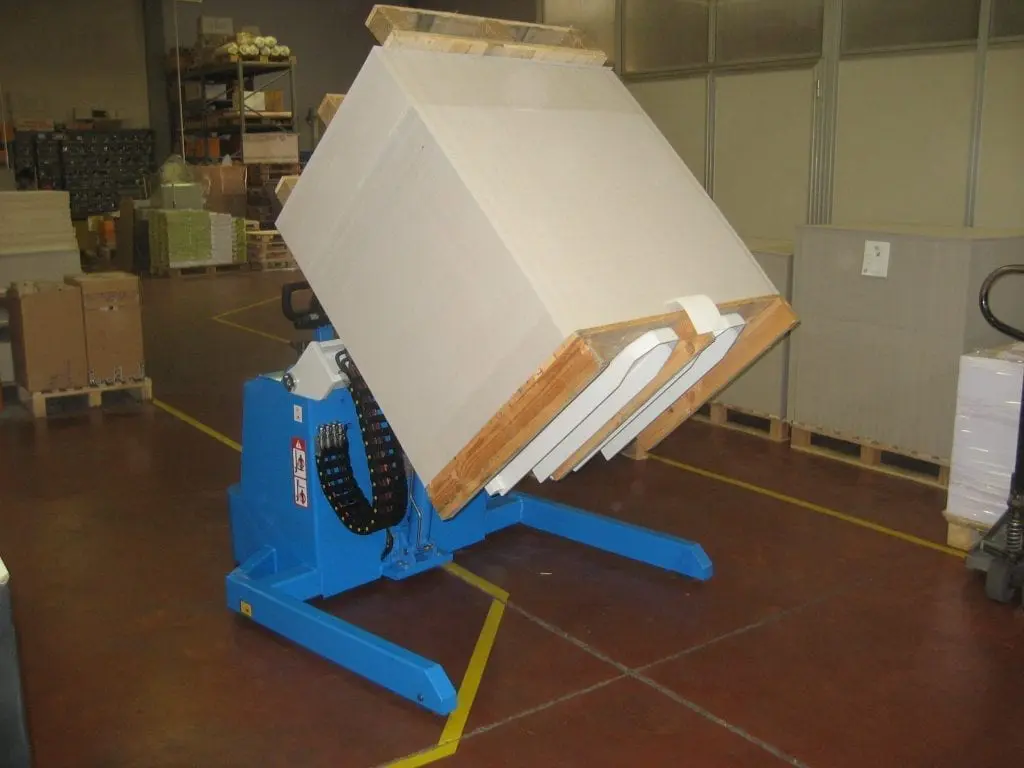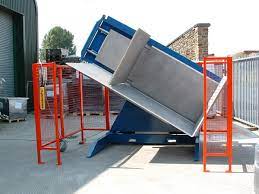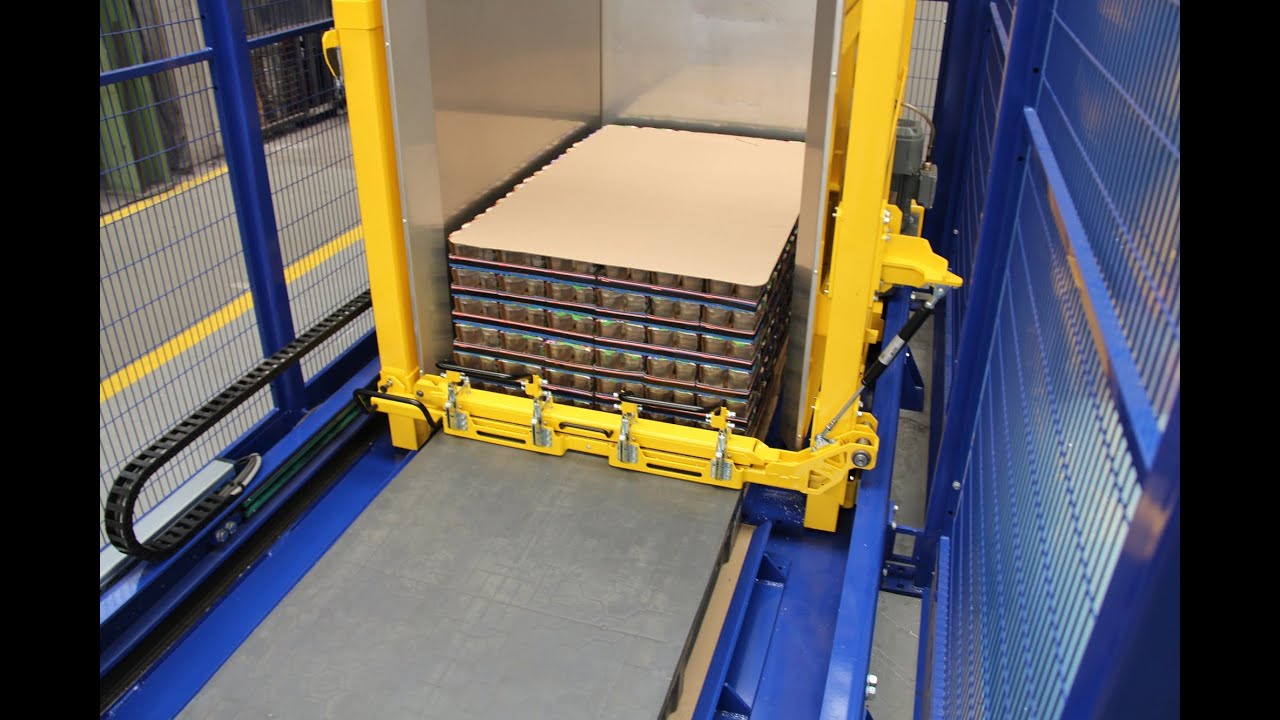Meeting Multi-Standard Adaptability Across EU Warehouse Requirements with Automated Pallet Exchange
You work hard to manufacture high-quality products. Your production line is efficient. You secure a major order from a client in Europe. Your team carefully loads the goods onto sturdy pallets, and the shipment begins its journey across the ocean. Then, you get the call. The shipment has arrived at a warehouse in Germany, but it's stuck at the receiving dock. Your pallets don't meet the local standard. Now, you are facing costly delays, fees for manual repalletizing, and the risk of your product being damaged by workers rushing to fix the problem. This single, small issue of a non-standard pallet has just created a massive headache and eroded the profit on the entire order. This isn't just a logistics issue; it's a direct threat to your efficiency and your reputation with valuable clients.
Automated pallet exchange systems provide a direct solution for multi-standard adaptability in European warehouses. These machines work by mechanically lifting, tilting, or clamping a full load of goods to seamlessly swap the original shipping pallet with a destination-compliant one. This automated process ensures your products meet local requirements, such as the standard Euro-pallet (EUR) or pooled CHEP pallets. It completely removes the need for slow, risky manual handling, which cuts down on labor costs, eliminates delays at the receiving dock, and prevents product damage during the transfer.

I've seen this exact problem derail countless shipments during my years in the industry. It's a frustratingly common bottleneck for companies expanding into new markets. A simple piece of wood can bring a multi-million dollar supply chain to a halt. But the solution is simpler than you might think. This technology isn't just a fix for a minor inconvenience. It's a strategic tool that can unlock greater efficiency and reliability for your entire export operation. Let’s explore how these systems work and how they can be a game-changer for your business.
How do automated pallet exchangers handle different pallet sizes and standards?
You are a practical person. You know that a pallet that is perfect for shipping from your factory might be completely wrong for a warehouse in another country. You might ship on standard 48"x40" pallets, but your customer in France or Italy needs everything on 1200x800mm Euro-pallets. The idea of buying a machine to solve this is appealing, but you worry it will be a one-trick pony. What happens if a new standard emerges, or you start shipping to a facility that uses plastic pallets instead of wood? You cannot afford to invest in an inflexible piece of equipment that will be obsolete in a few years.
Modern automated pallet exchangers are designed specifically for flexibility. They handle different pallet sizes and standards using adjustable clamping systems and versatile platform designs. Onboard sensors detect the dimensions of the incoming load and its pallet. This allows the machine's control system to automatically adjust the clamping pressure and positioning for a secure grip. The core transfer mechanism, whether it is a pusher, an inverter, or a tipper, is engineered to gently separate the product from its original pallet and place it precisely onto the new, standard-compliant pallet, regardless of small variations in size or construction.

The Mechanics of Adaptability
From my experience as an engineer, the beauty of these machines lies in their clever mechanical designs. There isn't just one type of pallet exchanger; there are several, each suited for different kinds of products and operational needs. The three most common types are pallet inverters, pallet pushers, and pallet tippers.
A pallet inverter is often the most versatile. It clamps the load from the top and bottom, then rotates the entire load 180 degrees. The original pallet is now on top and can be easily removed. A new pallet is placed on the load, and the machine rotates back 180 degrees. This method is excellent for stable, boxed goods or durable bags.
A pallet pusher, also known as a pallet changer, works differently. The load is pushed from the original pallet onto a slip-sheet or directly onto a waiting destination pallet. This method is ideal for more fragile or less stable loads, as it avoids tilting or inverting. The pressure and speed of the push are carefully controlled to ensure the product stack remains intact.
A pallet tipper is a simpler, robust solution often used for heavy, non-fragile goods. It tilts the load back 90 or 100 degrees, allowing the pallet to slide away by gravity. A new pallet is then inserted, and the load is tilted back down. This is fast and effective for things like crates of beverages or metal parts.
Key Features for Multi-Standard Operations
The real magic is in the features that allow these machines to be so adaptable. The most important one is the use of a Programmable Logic Controller (PLC). This is the machine's brain. You can pre-program it with the specifications for different pallet types. An operator can simply select "US to EUR" or "Wood to CHEP" on a touchscreen, and the machine adjusts its parameters automatically. These parameters include the clamping pressure from the side walls, the height of the top clamp, and the speed of the operation. Advanced sensors provide feedback to the PLC, ensuring the machine never applies too much force and damages your product.
| Feature | Pallet Inverter (180° rotation) | Pallet Pusher (Push/Pull) | Pallet Tipper (90° tilt) |
|---|---|---|---|
| Best For | Stable, boxed goods; sacks of material | Unstable loads, fragile items, glass bottles | Heavy, robust goods like steel coils or castings |
| Pallet Flexibility | High; accommodates many sizes easily | Very High; platform-based design is very forgiving | Moderate; load must be stable enough to tilt |
| Speed | Fast (30-60 seconds per cycle) | Moderate (45-90 seconds per cycle) | Fast (30-60 seconds per cycle) |
| Footprint | Compact and self-contained | Can be larger to accommodate push/pull area | Varies; often requires more overhead clearance |
What are the ROI and operational benefits of implementing pallet exchange systems?
As a business owner, you scrutinize every single investment. The final question is always, "What is the return?" You see the clear problem of non-standard pallets causing delays and extra costs. But is the price of an automated solution truly justified? You need to know if this is just a "nice-to-have" gadget or a genuine profit-driver for your operation. You look at the costs of labor, the time wasted at receiving docks, the potential for worker injuries from manual handling, and the value of products damaged in the process. These costs are real, and they add up quickly, quietly eating away at your profit margins. But building a solid business case for a new capital expenditure requires clear numbers and benefits.
The return on investment (ROI) for an automated pallet exchanger is often much faster and broader than people expect. It extends far beyond simply replacing two workers with a machine. A pallet exchanger delivers significant, measurable savings in operational efficiency, workplace safety, and product integrity, directly boosting your bottom line. Operationally, the benefits are immediate. You improve worker safety by eliminating the strenuous and risky task of manual lifting. You enhance product integrity by preventing the dents, scrapes, and breakages that happen during clumsy manual transfers. And you achieve faster dock-to-stock times, which increases your warehouse's overall throughput and capacity without adding more space.

Calculating the Tangible ROI
When I help clients evaluate this technology, we start with the hard numbers. The math is straightforward and compelling. First, look at labor. Manually repalletizing is slow and requires at least two workers. You pay their wages, benefits, and insurance. An automated system requires only one supervisor for multiple lines, or can be fully integrated into a conveyor line. The labor savings alone are often enough to justify the investment in under 18 months.
Next, consider product damage. Manual handling is clumsy. Boxes get dropped, corners get crushed, and bags get torn. Even a low damage rate of 1-2% adds up to a huge loss over a year. An automated system handles products gently and consistently, reducing damage rates to near zero. Then there are the pallet rental fees. If you use a pallet pooling service like CHEP or PECO, you pay for every day you have their pallets. Slow manual exchange processes mean you hold onto incoming pallets for longer, racking up fees. An automated system can swap a pallet in under 60 seconds, allowing you to return rented pallets almost immediately and slash these rental costs.
The Intangible Operational Gains
The financial return is clear, but the operational benefits are just as important. Workplace safety is a major one. Lifting heavy, awkward loads is a leading cause of back injuries. Removing this task protects your employees and reduces your risk of costly workers' compensation claims. Then there's the benefit of speed. An automated system can process 40-60 pallets per hour, while a manual team might struggle to do 10-15. This massive increase in throughput eliminates bottlenecks at your receiving dock and gets products into storage or onto the production line faster. This speed and reliability also enhance your reputation. When your customers know your shipments will always arrive on the correct pallet and clear their receiving process without issue, you become a preferred supplier. This builds trust and loyalty that goes beyond a simple price comparison.
| Cost Category | Manual Repalletizing | Automated Pallet Exchange | Savings |
|---|---|---|---|
| Labor Cost | 2 workers x 8 hours/day | 0.25 operator oversight | Significant reduction in direct labor costs |
| Cycle Time | 5-10 minutes per pallet | < 1 minute per pallet | Over 80% reduction in processing time |
| Product Damage Rate | 1-3% of goods value | <0.1% of goods value | Substantial savings on lost product |
| Workplace Injury Risk | Medium to High | Very Low | Reduced insurance premiums and claims |
| Pallet Rental Fees | High (due to slow return) | Low (due to fast exchange) | Drastic reduction in rental pallet costs |
How does pallet automation integrate with existing Warehouse Management Systems (WMS)?
You have invested significant capital and effort into building a smart factory. You have a powerful Warehouse Management System (WMS) that gives you visibility and control over your inventory. The last thing you want is to install a new piece of equipment that is effectively "dumb" and disconnected, creating a new island of information in your otherwise integrated operation. The thought of a machine that cannot communicate with your existing systems is a real problem. It means someone has to perform manual data entry. It opens the door for human error. It is a step backward from your goal of achieving total digitalization and a single source of truth for your operations.
Fortunately, modern pallet automation is designed for exactly this kind of seamless integration. These machines are not standalone islands. They are built to act as intelligent nodes within your larger logistics network. They communicate directly with your WMS or Manufacturing Execution System (MES) using standard industrial protocols. This ensures that data flows just as smoothly and automatically as your products do. The pallet exchanger becomes another tracked and controlled asset in your digital ecosystem, providing valuable data and executing tasks based on commands from your central system.

The Technical Connection
From an engineering standpoint, making this connection is quite standard. The pallet exchanger is controlled by its own PLC. This PLC can "talk" to your WMS or the main factory control system through common communication protocols like OPC-UA, EtherNet/IP, or PROFINET. Think of these protocols as a shared language that industrial machines use to understand each other.
The process is simple and powerful. Your WMS identifies a pallet that needs to be exchanged, perhaps via a barcode scan upon arrival. The WMS then sends a job order to the pallet exchanger's PLC. This order might say, "Take the load from pallet #12345 (US type) and move it to a new EUR pallet." The pallet exchanger's PLC receives the command, confirms it, and executes the physical task. Once the cycle is complete, it sends a message back to the WMS confirming "Job complete." If there's an issue, it can send a specific error code, allowing your maintenance team to be alerted instantly. This two-way communication creates a closed-loop system that is fully automated and requires no human intervention.
The Benefits of a Connected System
Integrating your pallet exchanger with your WMS unlocks a new level of operational intelligence. The primary benefit is complete visibility. You can now track a product's journey from the moment it leaves your production line to the moment it's placed on a shelf in a European warehouse, all within a single system. This eliminates informational black holes. This connectivity drastically improves inventory accuracy. The WMS knows in real-time that a product has been successfully transferred to a new pallet type and is now ready for put-away. It can also enable automated decision-making. For example, your WMS can be programmed to automatically route any incoming pallet with a non-standard barcode directly to the pallet exchanger before it ever reaches the main storage area, streamlining the entire receiving process.
| Integration Level | Description | Key Benefit |
|---|---|---|
| Level 1: Standalone | The machine operates independently. A worker pushes a button to start the cycle. | Simple to set up and has the lowest initial cost. |
| Level 2: Basic I/O | Simple start/stop/complete signals are exchanged with an adjacent conveyor system. | Automates the physical flow of pallets in and out of the machine. |
| Level 3: PLC-to-WMS | The pallet exchanger's PLC communicates directly with the WMS via a gateway. | Full data exchange, including job orders, status tracking, and error reporting. |
| Level 4: Full IoT | The machine acts as an IoT device, sending rich data to a cloud platform for analysis. | Enables predictive maintenance, performance analytics, and remote diagnostics. |
My Insight: A Strategic View on Automation for the Steel Industry
Javier, when I look at your profile, I see a journey that feels very familiar. I also started my career as an engineer on the factory floor and eventually built my own successful factory. I understand the immense pressure of managing large-scale operations, the constant search for efficiency, and the weight of making major capital investment decisions. As the owner of a steel mill, you might look at a machine like a pallet exchanger and think, "That's a logistics detail. That's for my warehouse manager to worry about." Your focus is rightfully on the big, critical challenges: the fluctuating cost of energy, the performance of your high-furnace, and the volatile demands of the global market.
It's natural to overlook what seem like small, downstream problems when you are responsible for an operation producing millions of tons a year. But my experience has taught me a crucial lesson. These "small" points of friction—in packaging, in material handling, in logistics—are like sand in the gears of a massive, powerful engine. Individually, they seem minor. But together, they add up to create significant drag, generating hidden costs and inefficiencies that directly impact your profitability and your ability to meet your primary goals. True operational excellence, I have found, comes from optimizing the entire value chain, from the moment steel is poured to the moment it arrives safely at your customer's facility. A pallet exchanger isn't just a machine for swapping pallets; it is a strategic tool that directly addresses your core challenges of cost reduction, digitalization, and becoming an indispensable partner to your clients.

Let's connect this specific technology directly to your stated goals. You aim to reduce overall operating costs by over 8%. A pallet exchanger contributes to this by attacking the soft, hidden costs. It's not just about labor. It's about eliminating product damage during shipping. When you ship steel coils or high-value steel wire, any damage in transit is a complete loss. It’s about avoiding late fees and penalties from your customers or logistics partners. These savings go straight to your bottom line.
You want to propel your数字化转型 by deploying MES and IoT platforms. A modern pallet exchanger is a perfect, practical application of this strategy. It is an intelligent, connected machine that becomes a data-gathering node for your MES. It provides clear, actionable data on a critical transition point in your supply chain. It tells you exactly when a product is ready for the next stage, how long the process took, and if any issues occurred. This is how you build a truly transparent, data-driven operation—one practical, high-ROI application at a time.
Finally, think about what it means to be a strategic partner. Your customers in the automotive and construction industries operate on tight schedules. A delay at their receiving dock because of a pallet issue can disrupt their entire production line. When you proactively solve this problem for them, you are doing more than just supplying steel. You are supplying reliability. You are making their operation run smoother. This is how you build deep, lasting relationships that are not based solely on price. You become an integrated part of their success. This is the ultimate competitive advantage, and it’s built by paying attention to every detail, right down to the pallet the product sits on.
Conclusion
Automated pallet exchange is a key tool for global exporters. It solves multi-standard challenges, boosts ROI, and integrates seamlessly, turning a logistical problem into a powerful competitive advantage.




